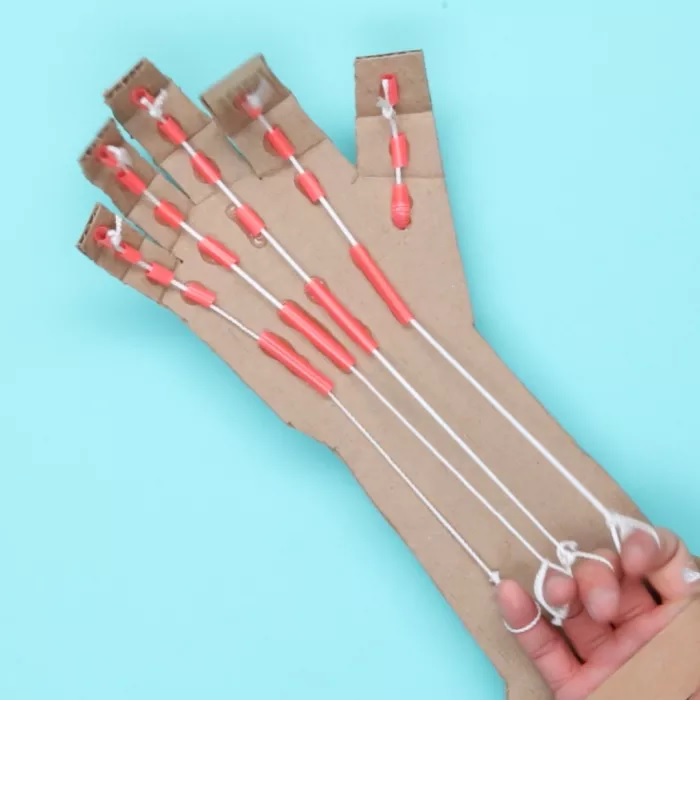A Show of Hands
A Handful of STEAM Activities!
Can you make a list of all the things you use your hands for...
How many things could you come up with?
The Beginning
Did you know that our hands actually evolved from fish fins, also called lobe fins? True story! Fish, called elpistostegalian fishes or tetrapods, migrated out of the water and onto land in search of food. Over time, their fins slowly transformed (through evolution) into hand-like structures with 7 or 8 fingers so that they could better live and move on solid ground. These animals used their hands almost like a second set of feet to help them walk or crawl on all fours (quadruped). Today's modern humans, like us, stand upright and walk on 2 feet (bipedal), freeing up our hands and fingers for other important tasks and projects.
Checkout this video to see a recreation: Ancient Fish Fingers
WALK-THE-WALK CHALLENGE: Try walking from one side of the room to the other, chimpanzee style, using both your hands and feet on the floor. Then try doing it again, human style, using only your feet. Time yourself to see if you are faster as as a quadruped or biped.
Hands Today
Our hands are made up of many parts that help make them bend and work (dexterity)
There are 27 bones in the hand
They are separated into 5 different groups.
They are separated into 5 different groups.
Many other parts help make the hand work
MOVE: Wiggle and dance your fingers along to this fun video about the parts of our hands
It's All in the Thumbs
THUMB CHALLENGE: Try to do these things without using your thumbs.
1. Write your name with a pencil
2. Put on a sock and shoe
3. Open a door using a knob
4. Brush or comb your hair
5. Button a button
6. Tie a shoelace
7. Blow up a balloon and tie it
8. Seal a plastic bag
9. Pull up a zipper
10. Pick a coin up off a flat surface
11. Brush your teeth
12. Open a jar
2. Put on a sock and shoe
3. Open a door using a knob
4. Brush or comb your hair
5. Button a button
6. Tie a shoelace
7. Blow up a balloon and tie it
8. Seal a plastic bag
9. Pull up a zipper
10. Pick a coin up off a flat surface
11. Brush your teeth
12. Open a jar
Report your results in a chart
Build a Robotic Hand
Try your hand at building your own robotic hand. Here is what you will need to do.
Robots and Hands... They Go Hand-in-Hand
We work and direct our hands and fingers to do all the amazing things they do through remote control using our brains.
Scientists and engineers have been using human hands as models for robot arms and hands for many years as tools to help humans with different things.
Leonardo Da Vinci is thought to have made one of the very first robotic arms and hands using pulleys in 1495 ... that's over 500 years ago!
Since then, robotic hands have continued to get more sophisticated. They are now used in many ways, such as machines in factories and as prosthetic limbs.
Try your hand at building your own robotic hand. Here is what you will need to do.
Required Materials:
- Straws
- Card stock or card board (you can also use a glove)
- Scissors
- Pencil
- Yarn or String (various colors)
- Tape
- Jumbo straw (optional)
Instructions:
1. Make the Hand
Trace a hand onto card stock or cardboard and cut out. (An adult's hand may work better)
2. Mark the Joints
Place your hand back onto the paper hand and mark the location of your joints (where your fingers bend - this is where your bones meet). Fold the paper hand at the joint marks.
3. Add the Straws
Cut the straws into ¼", ½", 1", and 2 ¼" sizes or whatever works between the joint marks. Tape the straws onto the hand, leaving a gap where the joints fold. (If you have available, tape the jumbo straw onto the wrist.)
4. Add the Yarn
Using a different yarn color for each finger (if available), cut five strands of yarn into 2-foot-long pieces. Knot one end of each piece of yarn. Thread one yarn strand through each finger using the side that does not have a knot.. Use a different yarn color for each finger. The colors for each finger should meet at the wrist.
If a large straw is not available for the wrist, make a loop at the end of each piece of yarn for the fingers to go.
5. Pull and Play!
Put your robot's joints, muscles, and tendons to work.
Having Trouble?
Check out this instructional video for help.
Give yourself a hand for a job well done!
Check out a handful more of hand activities and resources
ACTIVITIES
- Learn Sign Language with Gail Borden Library
- Make Shadow Puppets
- Have Fun with Finger Play
- Make Finger Puppets
RESOURCES
- Fish with fingers missing link in evolution of human hand
- The Science of Hands
- Evolution of the Thumb
Hands are awesome appendages. We need to be sure to take good care of them.
Here is Baby Shark with a reminder to always wash our hands!





















